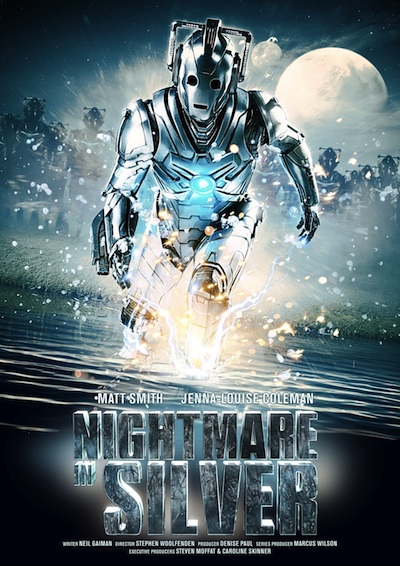 It probably does not come as a surprise to most people, but “Nightmare in Silver” has been the one episode this series that I have been most looking foreword to.
It probably does not come as a surprise to most people, but “Nightmare in Silver” has been the one episode this series that I have been most looking foreword to.
Neil Gaiman is one of my favorite writers, and his previous episode, “The Doctor’s Wife”, is Doctor Who‘s best episode. Most people point to “Blink” as the best episode and it is great; however, “The Doctor’s Wife” managed to completely change the history of the show with a few seemingly simple brush strokes. It reshapes how the audience sees every single episode in the 50-year history and manages to make them more meaningful.
In fact, Neil Gaiman was actually the deciding factor for me to start watching Doctor Who. I had always been interested in the show, but since it ended when I was only a few years old, I did not really have the opportunity to watch it until the reboot. Shortly after Russell T. Davies regenerated the show, I saw a comment by Neil Gaiman where he mentioned that Doctor Who was one of the biggest influences in his life, which peaked my interest. Shortly after that, I read his biography on Douglas Adams which is where I learned of his work on the show, and at that point I knew that watching this show must become a priority for me.
My initial response to “Nightmare in Silver” was that it seemed vaguely familiar, but I could not figure out why. A couple of hours later, while I was still digesting the episode, it hit me: it is essentially a remake of The Seventh Seal. The classic Ingmar Bergman film follows a knight from the Crusades as he challenges Death to a game of chess in order to prolong his life. As the game goes on, he starts using the game as a distraction to get Death to forget about a family, so that they will be saved from the plague. This is a gross oversimplification, but this is a Doctor Who review and not a review of The Seventh Seal, so let’s save that critique for another time.
I have to go on a tangent for a moment about another gross oversimplification of said movie. I once overheard a conversation between a man and a woman about movies. He appeared to know nothing about film, yet did not let ignorance stop him from talking. When they passed a copy of The Seventh Seal, she expressed interest in it and he explained that she would not like it because it was a movie about chess. By his logic, she would probably not like Citizen Kane since, you know . . . it is a movie about a sled. During this interaction, I kept wishing that I had Marshall McCluhan waiting in the wings, so I could bring him out to reprimand this fool.
But, back to the actual thing I am reviewing. The Cybermen have returned, and they have had some major upgrades. Probably the biggest upgrade entails their conversion process. It now appears to be nearly instantaneous, and they can now convert binary vascular creatures such as the Doctor. In the past, it was established that he is incompatible—this is no longer true. The Doctor can now be converted into a Cyberman, and his intellect would be the greatest weapon they could ever hope to attain. After the conversion, tech is attached to him, and he is able to hold it to a stalemate.
Neil Gaiman’s writing tends to be rather cerebral, and in this case that is quite literal as the Doctor and the Cyber-planner fight inside his head for control of his mind. And, here is where it starts to resemble The Seventh Seal. In order to reverse the conversion of Artie and Angie (the children that Clara takes care of who have tagged along for this adventure), the Doctor challenges the Cyber-planner to a game of chess. If he wins, the controller will release the trio, if he loses he will relinquish control of his mind.
This mental battle gives Matt Smith the opportunity to play both hero and villain in this episode. He not only performs both brillaintly, but also appears to be enjoying every second of it. He managed to perfectly balance the dichotomy between whimsical and malevolent. This mental sparring brought about a plethora of nods to previous episodes that once again reminds us all just how much Gaiman is invested in Doctor Who mythos.
Just like in “The Doctor’s Wife,” he managed to resurrect some old concepts from Doctor Who, as well as incorporate some of his own. The casual viewer may not be aware that, over the course of the show, there have actually been two different categories of Cybermen. There are the classic Cybermen as well as the rebooted versions. When they were reintroduced in Series 2, they invaded from a parallel universe (sometimes referred to as Pete’s World) with an updated look and lacking a susceptibility to gold. Their armor appears to be an upgraded iteration of the newer Cybermen (which makes them look even more like Samus Aran now) while still maintaining some of the classic flaws. It appears that the two types have incorporated each other and become one. These new hybrid Cybermen now have the ability to constantly upgrade themselves, making them more menacing as they can now adapt to overcome individual obstacles. He has also updated the Cybermats by making them smaller and more dangerous, causing the Doctor to nickname them Cybermites.
This episode also saw Warwick Davis add another sci-fi/fantasy franchise to his list of accomplishments. What can I saw about him other than his performances always make me smile? After this week’s episode, both he and Neil Gaiman will return to Doctor Who very soon.

